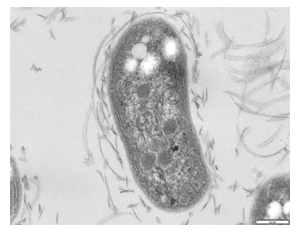Nitrobacter
The genus Nitrobacter consists of gram-negative (gram staining negative) bacteria with pear-shaped or different-sized rod shapes. Their size is around 0.5-0.9um in width and 1.0-2.0 um in length. The optimal growth temperature is between 28 and 30 °C, and the optimal pH is 7.5 ~8.0.[1]
Nitrobacter bacteria reproduce by separating a body into two new parts (binary fission) or by budding (when new individuals develop from parent organisms).[1] Nitrobacter grow at a quite slow rate.[2]
Nitrobacter spp. generally occur in soil and water and are organisms that derive energy from chemical reactions (chemoautotrophic). They possess compartments inside their cells, which contain a specific type of protein (enzyme nitrite oxidoreductase.[3]
Nitrobacter bacteria are responsible for the conversion (oxidation) of nitrite (NO2−) to nitrate (NO3-).[4] The chemical reaction is shown below.[5] This reaction is called nitrification and it is coupled with low rates of carbon fixation via the Calvin cycle.[6]
[math]\ce{ NO2- + H2O -> NO3- + 2H+ + 2e- }[/math]
Nitrification benefits plant growth and is important to the ocean, as it takes about half of the nitrate consumed by phytoplankton (microscopic marine algae) growth.[7] However, it also may lead to eutrophication (enriching the water with nutrients, generally nitrogen/phosphorus) and drinking water pollution.[4]
In the presence of oxygen, Nitrobacter bacteria use nitrite as the energy source and utilize carbon dioxide as the main source of carbon. Nitrobacter bacteria can also carry out anaerobic respiration (without oxygen) by reducing nitrate to nitrite, nitric oxide (NO) and nitrous oxide (N₂O).[1]
History
Russian microbiologist Sergei Winogradsky first found nitrification and isolate first nitrifiers. He also found these nitrifiers were chemoautotrophic.[8]
- ↑ 1.0 1.1 1.2 Garrity, George M.; Bell, Julia A.; Lilburn, Timothy (2005), Brenner, Don J.; Krieg, Noel R.; Staley, James T. (eds.), "Class I. Alphaproteobacteria class. nov.", Bergey’s Manual® of Systematic Bacteriology: Volume Two The Proteobacteria Part C The Alpha-, Beta-, Delta-, and Epsilonproteobacteria, Boston, MA: Springer US, pp. 1–574, doi:10.1007/978-0-387-29298-4_1, ISBN 978-0-387-29298-4, retrieved 2022-07-22
- ↑ Zhang, Y.; Zhang, Y.; Gao, J.; Shen, Q.; Bai, Z.; Zhuang, X.; Zhuang, G. (September 2018). "Optimization of the medium for the growth of Nitrobacter winogradskyi by statistical method". Letters in Applied Microbiology. 67 (3): 306–313. doi:10.1111/lam.13036. PMID 29931785. S2CID 49337993.
- ↑ Myrold, David D. (2021-01-01), Gentry, Terry J.; Fuhrmann, Jeffry J.; Zuberer, David A. (eds.), "15 - Transformations of nitrogen", Principles and Applications of Soil Microbiology (Third Edition), Elsevier, pp. 385–421, ISBN 978-0-12-820202-9, retrieved 2022-07-22
- ↑ 4.0 4.1 Pepper, Ian L.; Gerba, Charles P. (2015-01-01), Pepper, Ian L.; Gerba, Charles P.; Gentry, Terry J. (eds.), "Chapter 10 - Cultural Methods", Environmental Microbiology (Third Edition), San Diego: Academic Press, pp. 195–212, ISBN 978-0-12-394626-3, retrieved 2022-07-22
- ↑ Prosser, J. I. (2005-01-01), "NITROGEN IN SOILS | Nitrification", in Hillel, Daniel (ed.), Encyclopedia of Soils in the Environment, Oxford: Elsevier, pp. 31–39, ISBN 978-0-12-348530-4, retrieved 2022-07-22
- ↑ Ward, B. B. (2013-01-01), "Nitrification☆", in Fath, Brian (ed.), Encyclopedia of Ecology (Second Edition), Oxford: Elsevier, pp. 351–358, ISBN 978-0-444-64130-4, retrieved 2022-07-22
- ↑ Yool, Andrew; Martin, Adrian P.; Fernández, Camila; Clark, Darren R. (June 2007). "The significance of nitrification for oceanic new production". Nature. 447 (7147): 999–1002. doi:10.1038/nature05885. ISSN 1476-4687. PMID 17581584. S2CID 4416535.
- ↑ Dworkin, Martin; Gutnick, David (2012-03-01). "Sergei Winogradsky: a founder of modern microbiology and the first microbial ecologist". FEMS Microbiology Reviews. 36 (2): 364–379. doi:10.1111/j.1574-6976.2011.00299.x. ISSN 0168-6445. PMID 22092289.
